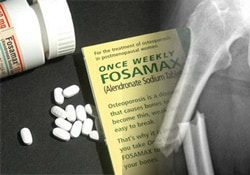
National law firm, Parker Waichman LLP, just filed a lawsuit on behalf of a woman who took Fosamax (alendronate) and subsequently suffered a femur fracture; the lawsuit alleges that Merck’s osteoporosis drug caused the fracture. The Fosamax lawsuit was filed on June 4th in the Superior Court of New Jersey, Atlantic County Law Division (Case […]
 National law firm, Parker Waichman LLP, just filed a lawsuit on behalf of a woman who took Fosamax (alendronate) and subsequently suffered a femur fracture; the lawsuit alleges that Merck’s osteoporosis drug caused the fracture. The Fosamax lawsuit was filed on June 4th in the Superior Court of New Jersey, Atlantic County Law Division (Case No. ATL-L-3854-12). Defendants named are Merck Sharp & Dohme Corp., Merck & Co., Inc., and other companies who may manufacturer the drug.
National law firm, Parker Waichman LLP, just filed a lawsuit on behalf of a woman who took Fosamax (alendronate) and subsequently suffered a femur fracture; the lawsuit alleges that Merck’s osteoporosis drug caused the fracture. The Fosamax lawsuit was filed on June 4th in the Superior Court of New Jersey, Atlantic County Law Division (Case No. ATL-L-3854-12). Defendants named are Merck Sharp & Dohme Corp., Merck & Co., Inc., and other companies who may manufacturer the drug.
The U.S. Food & Drug Administration (FDA) recently published research questioning if Fosamax and other bisphosphonates have any long-term benefits; other studies continue to link the medications to atypical femur fractures.
The complaint states that the woman began taking Fosamax around December 2004 and suffered a left femur fracture in September 2009. The lawsuit claims this injury is a direct result of using Fosamax for several years, and alleges consequences including severe mental and physical pain and suffering, permanent injuries and emotional distress, economic loss due to medical expenses, and living related expenses due to a new lifestyle.
The FDA approved Fosamax in 1995 to treat conditions such as osteoporosis and Paget’s disease. As a bisphosphonate, Fosamax attempts to reverse or reduce the effects of bone loss from these diseases by increasing bone mineral density (BMD). The lawsuit alleges that increased BMD does not imply a reduced fracture risk and that bisphosphonates such as Fosamax, increase risks for atypical fractures by making bones become highly mineralized, homogenous, and brittle
The lawsuit also alleges that the Merck and the other defendants knew about the defective nature of Fosamax and did not adequately warn users about the risk and that the defendants neglected to conduct sufficient post-marketing Fosamax surveillance. According to the lawsuit, the plaintiff would not have used Fosamax had the defendants appropriately warned patients about the risks associated with the drug, especially given that safer alternatives, such as vitamin D and calcium supplements, are available.
In October 2010, the FDA announced that the safety label of Fosamax, Fosamax Plus D, and other bisphosphonates would be changed to include information on the potential for increased risk of atypical fractures. While the agency did not draw any definitive causal relationships, it stated that “unusual femur fractures have been predominantly reported in patients taking bisphosphonates.”
Meanwhile two bisphosphonate studies were just published including an FDA-published review of clinical trials involving 2,342 post-menopausal women that was published in the New England Journal of Medicine. Overall, the agency did not find strong evidence for the drugs’ benefits after five years of treatment. The Archives of Internal Medicine also published a study where 82 percent of patients with atypical femur fractures took bisphosphonates.
Meanwhile, a new study of adverse event reports involving Fosamax and other bisphosphonates found that the risk of esophageal cancer associated with these drugs may be higher than first thought. Also, last summer, the FDA issued a Drug Safety Communication to update the public on its ongoing review of the possible association between oral bisphosphonate drugs and an increased risk of esophageal cancer. At that time, the agency noted that the two studies it reviewed had reached conflicting conclusions and, while the FDA said it believed the benefits of bisphosphonates continued to outweigh their risks, it acknowledged that further study of the issue was needed. Its safety review is ongoing.


